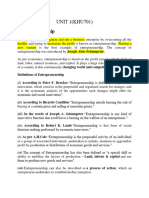Govt - Non Govt - in Entrepreneurship
Govt - Non Govt - in Entrepreneurship
Uploaded by
Kee RtiCopyright:
Available Formats
Govt - Non Govt - in Entrepreneurship
Govt - Non Govt - in Entrepreneurship
Uploaded by
Kee RtiOriginal Description:
Original Title
Copyright
Available Formats
Share this document
Did you find this document useful?
Is this content inappropriate?
Copyright:
Available Formats
Govt - Non Govt - in Entrepreneurship
Govt - Non Govt - in Entrepreneurship
Uploaded by
Kee RtiCopyright:
Available Formats
REPORT ON GOVERNMENT AND NON-GOVERNMENTAL ASSISTANCE IN ENTREPRENEURSHIP
SUBMITTED TO:
SUBMITTED BY:
INTRODUCTION:
Entrepreneurship plays a dominant role in the growth and development of the economy. Entrepreneurship can solve the problems like unemployment, concentration of economic power in few hands, imbalanced regional development, increasing wastage of youth power in destructive activities. Entrepreneurship is the ability to start a new enterprise to earn profits by producing or marketing of goods & services to meet the needs and requirements of customers. It is the ability & quality of entrepreneur to identify an investment opportunity & to organize an enterprise in order to contribute for the real economic growth.
ENTREPRENEURSHIP Entrepreneurship is the investing and risking of time, money, & effort to start a business & make it successful. Entrepreneurship is essentially a creative activity or it is a n innovation function. The process of innovation may be in form of : Introduction of a new product. Use of a new method of production. Opening of a new market. The consequent of new source of supplying raw material. A new form of organization. According to Jagroop Singh, Entrepreneurship is what an entrepreneur doesinnovation, risk-taking, decision making, organization building, leadership, gap filling, exploiting an economic opportunity. There are basically two types of entrepreneurship, viz., (1) Opportunitybased entrepreneurship--in which an entrepreneur perceives a business
opportunity and chooses to pursue this as an active career choice and (2) Necessity-based entrepreneurship--in which an entrepreneur is left with no other viable option to earn a living, that is, here it is not the choice but compulsion, which makes him/her, choose entrepreneurship as a career. According to the present day theory, an entrepreneur is one who is innovative. The necessary characteristic of the entrepreneur is alertness, and no intrinsic skills other than that of recognizing opportunities, are necessary. Leibenstein (1995) opines that an entrepreneur must be dominant, and be gap-filler, i.e. have the ability to perceive where market fails and to develop new goods or processes that the market demands but which are not currently being supplied. Thus, entrepreneurs must have the special ability to connect different markets and make up for market failures and deficiencies. Innovation means a new way of doing something and may refer to incremental, radical, and revolutionary changes in thinking, products, processes, or organizations. Invention is different from innovation, in that it is an idea made manifest, whereas in innovation, an idea is applied successfully. Entrepreneurship and innovation are two terms that are often seen together. Creating an entrepreneurial firm requires innovation to enjoy high rates of growth and higher than industry rates of profitability. To achieve this requires innovation: an ability to solve problems profitably while offering superior quality of service or goods. One of the reasons why innovation seems to go hand in hand with entrepreneurship is that entrepreneurs would not achieve success in building a high growth, highly profitable business if they did not bring innovative approaches to the marketplace.
Innovation and entrepreneurship are two sides of a coin. While there is a need for the innovations to occur which should be facilitated and even encouraged deliberately by entrepreneurs, it is equally important for them to create opportunities and environment to realize those innovations. There is no single, but a combination of factors such as market opportunity, family background in entrepreneurship, a new idea with business potential, the prospect of challenge offered by Entrepreneurship, as well as long cherished dreams and desire, that lead to successful entrepreneurship.
Today, innovation is about many more than new products. It is about reinventing business processes and building entirely new markets that meet untapped customer needs. Most important, as the Internet and globalization widen the pool of new ideas, it's about selecting and executing the right ideas and bringing them to market in record time. In the 1990s, innovation was about technology and control of quality and cost. Today, it's about taking corporate organizations built for efficiency and rewiring them for creativity and growth.
LOCAL GOVERNMENT ROLES AND RESPONSIBILITIES
The local governments roles and responsibilities are outlined in 24 CFR Part 570.501. As the applicant, the local government is responsible as follows: Management and Oversight: The elected officials are legally, financially, contractually and programmatically responsible for the CDBG project. The local government is responsible to the State of North Carolina and the Federal government even if they have a contract administrator or sub-recipient relationship. Financial Management: The local government must ensure proper accounting of funds in order to avoid disallowed costs. This includes accurate identification of project costs and cash balances and proper internal controls.
Statement of Assurances and Certifications: The local government elected officials and administrators should read and understand these documents and the implementation obligations. Grant Agreement (24 CFR Part 570.501 and .502): If awarded, the local government will receive a grant agreement and funding approval from the State. These documents are contractually binding. The documents cannot be changed without State approval.
You might also like
- c11 MergersDocument5 pagesc11 MergersHuyen NguyenNo ratings yet
- PFN1223 - Set A - MSDocument8 pagesPFN1223 - Set A - MSalya farhanaNo ratings yet
- Learning Module For Senior High School: Subject: Discipline and Ideas in The Social SciencesDocument23 pagesLearning Module For Senior High School: Subject: Discipline and Ideas in The Social SciencesWET WATERNo ratings yet
- EntrepreneurshipDocument66 pagesEntrepreneurshipEng RaniaNo ratings yet
- EntreprenueDocument167 pagesEntreprenueChandni SachdevaNo ratings yet
- Entrepreneurship SummaryDocument36 pagesEntrepreneurship SummaryEng RaniaNo ratings yet
- Characteristics of Entrepreneurship: Economic ActivityDocument30 pagesCharacteristics of Entrepreneurship: Economic ActivityTariq IqbalNo ratings yet
- Entrepreneurship 1Document11 pagesEntrepreneurship 1im ahmedNo ratings yet
- Entrepreneurship Chapter 1Document5 pagesEntrepreneurship Chapter 1Kamlakar SadavarteNo ratings yet
- Business EntrepreneurshipDocument26 pagesBusiness EntrepreneurshipNixon FerrerNo ratings yet
- Unit - 1 (Khu802)Document29 pagesUnit - 1 (Khu802)iqbalmnitNo ratings yet
- Esd Module 2017Document104 pagesEsd Module 2017brendamusana02No ratings yet
- Chapter 1Document19 pagesChapter 1John NasasiraNo ratings yet
- Theories of EnterpriseDocument12 pagesTheories of Enterpriserehman darNo ratings yet
- Sem I Question BankDocument19 pagesSem I Question BankCheven 44No ratings yet
- Entrep Topic 1 2 and 3 ModuleDocument8 pagesEntrep Topic 1 2 and 3 ModuleChristy100% (1)
- Concept of Entrepreneur: Key TakeawaysDocument18 pagesConcept of Entrepreneur: Key TakeawaysVishwas Srivastava 371No ratings yet
- Entrepreneur PDF 2Document35 pagesEntrepreneur PDF 2INDIA TECHNo ratings yet
- Entrepreneurship Development NotesDocument97 pagesEntrepreneurship Development Notesrealguy556789No ratings yet
- The Concept of EntrepreneurshipDocument6 pagesThe Concept of EntrepreneurshipPrince Pulina Jr.No ratings yet
- Edpo 1234Document20 pagesEdpo 1234Rutvik DicholkarNo ratings yet
- The Concept of EntrepreneurshipDocument19 pagesThe Concept of EntrepreneurshipAleni renahNo ratings yet
- Internal Factors of EntreprenershipDocument24 pagesInternal Factors of EntreprenershipvinaypandeychandNo ratings yet
- Capacity Develop Manage Business Venture Risks Order Profit BusinessesDocument16 pagesCapacity Develop Manage Business Venture Risks Order Profit BusinessesP.lakshmanareddyNo ratings yet
- Concept of EntrepreneurshipDocument33 pagesConcept of EntrepreneurshipAnkush ChauhanNo ratings yet
- Ed Notes (Revised)Document77 pagesEd Notes (Revised)janakiraman sureshkumarNo ratings yet
- Short Answer of ED 1 To 45 (7th Sem)Document7 pagesShort Answer of ED 1 To 45 (7th Sem)somyasubham1414No ratings yet
- Entrep 5Document5 pagesEntrep 5Mylen Noel Elgincolin ManlapazNo ratings yet
- Esd Module 2017Document104 pagesEsd Module 2017professor dubeNo ratings yet
- Esbd - Unit IDocument39 pagesEsbd - Unit IpallaviNo ratings yet
- Feg 403 NoteDocument9 pagesFeg 403 NoteIniobong Fidelis InyangNo ratings yet
- Entrepreneurship & InnovationDocument31 pagesEntrepreneurship & InnovationSamruddhi KudalkarNo ratings yet
- Uniti Top Ten Reasons To Become EntrepreneurDocument35 pagesUniti Top Ten Reasons To Become EntrepreneursanthiamuthaNo ratings yet
- Entrepreneurship QDocument18 pagesEntrepreneurship Qafzal786435No ratings yet
- LOWERSIXTH ENTREPRENEURS NotesDocument15 pagesLOWERSIXTH ENTREPRENEURS NotestawungalemsNo ratings yet
- Irp 415Document9 pagesIrp 41519-66rp002No ratings yet
- 1637Document126 pages1637think0910No ratings yet
- New Slide of Entrepreneurship-2019 - 45Document124 pagesNew Slide of Entrepreneurship-2019 - 45laxmi suryavankshi thapaNo ratings yet
- Entrepreneurial Terms DefinitionDocument4 pagesEntrepreneurial Terms Definitionsamson mbeweNo ratings yet
- Pme Unit 1 MamDocument31 pagesPme Unit 1 MamShobhit SinhaNo ratings yet
- Capitalism and The Technology Entrepreneur: New Venture Opportunity (Or New Business Opportunity)Document4 pagesCapitalism and The Technology Entrepreneur: New Venture Opportunity (Or New Business Opportunity)Tejaswini MishraNo ratings yet
- Material EsbmDocument26 pagesMaterial Esbmmohammad ferozNo ratings yet
- Avi Drinking Water Industry 3Document46 pagesAvi Drinking Water Industry 3vv8389190No ratings yet
- Suresh (Entrprnur)Document180 pagesSuresh (Entrprnur)katta swathiNo ratings yet
- Eship Unit 1Document17 pagesEship Unit 1yogi reddyNo ratings yet
- Edp 1Document30 pagesEdp 1Nethaji sptNo ratings yet
- Class 12 EnglishDocument8 pagesClass 12 EnglishGautaml21No ratings yet
- Often Initially A - The People Who Create These Businesses Are Called EntrepreneursDocument7 pagesOften Initially A - The People Who Create These Businesses Are Called EntrepreneurspraneethNo ratings yet
- EntrepreneurDocument9 pagesEntrepreneurNupur SinghalNo ratings yet
- EnternurpshipDocument12 pagesEnternurpshipSaqib AhmadNo ratings yet
- Ent Chap 1Document38 pagesEnt Chap 1agreemforwardNo ratings yet
- 2019 Edp Unit 4Document33 pages2019 Edp Unit 4HoyoboyNo ratings yet
- Entrepreneurship 20Document6 pagesEntrepreneurship 20Princess RosalNo ratings yet
- BSENDocument11 pagesBSENprince stevenNo ratings yet
- Workshop On Developing Entrepreneurial SkillsDocument36 pagesWorkshop On Developing Entrepreneurial SkillsRouble VohraNo ratings yet
- Entreprenurship Unit 1Document13 pagesEntreprenurship Unit 1surya100% (1)
- Entrepreneurship: Characteristics, Importance, Types, and Functions of EntrepreneurshipDocument4 pagesEntrepreneurship: Characteristics, Importance, Types, and Functions of EntrepreneurshipMAMUNINo ratings yet
- EntrepreneurshipDocument30 pagesEntrepreneurshipJasmandeep brar100% (1)
- Entrepreneurship and Small Business Management - Un - 240708 - 100052Document34 pagesEntrepreneurship and Small Business Management - Un - 240708 - 100052yashnick254No ratings yet
- Innovation and Disruption: Unleashing the Power of Creative Thinking in BusinessFrom EverandInnovation and Disruption: Unleashing the Power of Creative Thinking in BusinessNo ratings yet
- The Art of Innovation: Unleashing Creativity for Business SuccessFrom EverandThe Art of Innovation: Unleashing Creativity for Business SuccessNo ratings yet
- Our Houses L No 13Document6 pagesOur Houses L No 13Kee RtiNo ratings yet
- Lesson 8 Weather and SeasonsDocument3 pagesLesson 8 Weather and SeasonsKee RtiNo ratings yet
- Basic Math Formulas - Docx78uDocument3 pagesBasic Math Formulas - Docx78uKee RtiNo ratings yet
- Punjab Current Affairs For PPSCDocument18 pagesPunjab Current Affairs For PPSCKee RtiNo ratings yet
- Short Essay On The Importance of Mathematics - Docx4njkjDocument1 pageShort Essay On The Importance of Mathematics - Docx4njkjKee RtiNo ratings yet
- Performa Total VotesDocument2 pagesPerforma Total VotesKee RtiNo ratings yet
- List of Candidates of 15 Aug 2016Document3 pagesList of Candidates of 15 Aug 2016Kee RtiNo ratings yet
- Chapter 4 - Externalities: Public FinanceDocument32 pagesChapter 4 - Externalities: Public FinanceMey MeyNo ratings yet
- GLOBALIZATION and MULTICULTURAL LITERACYDocument32 pagesGLOBALIZATION and MULTICULTURAL LITERACYNathaniel Remendado100% (4)
- David Held Is An Anarchist - Discuss by Alex PrichardDocument21 pagesDavid Held Is An Anarchist - Discuss by Alex PrichardNikos PapadakisNo ratings yet
- Distinction Between Inflationary and Deflationary Gap at The Equilibrium Level of IncomeDocument3 pagesDistinction Between Inflationary and Deflationary Gap at The Equilibrium Level of IncomeMukoya edward EdwardNo ratings yet
- Innovation Management NotesDocument4 pagesInnovation Management NotesMohd Izzudin100% (2)
- HW 2Document4 pagesHW 2Marino NhokNo ratings yet
- Child's GuideDocument14 pagesChild's Guidet59409t045No ratings yet
- Perfect Competetion in Laundry MarketDocument26 pagesPerfect Competetion in Laundry MarketBalpreet KaurNo ratings yet
- Practice Problems Ch. 12 Perfect CompetitionDocument5 pagesPractice Problems Ch. 12 Perfect CompetitionYolanda TshakaNo ratings yet
- Pengujian Efisiensi Pasar Pada Pasar Modal Indonesia Periode Juni 2009 - Juni 2015 (Studi Pada Indeks Harga Saham Gabungan)Document9 pagesPengujian Efisiensi Pasar Pada Pasar Modal Indonesia Periode Juni 2009 - Juni 2015 (Studi Pada Indeks Harga Saham Gabungan)hasamiwakasNo ratings yet
- PST ECON 2015 2023Document47 pagesPST ECON 2015 2023PhilipNo ratings yet
- Robert C. Merton, BiographyDocument5 pagesRobert C. Merton, BiographywilsonlariosNo ratings yet
- Res555 AssignmentDocument3 pagesRes555 AssignmentHannan Bt HizamNo ratings yet
- Does IT Pay Off HSBC and Citi Case StudyDocument8 pagesDoes IT Pay Off HSBC and Citi Case StudyIIMnotesNo ratings yet
- National Income QuestionsDocument9 pagesNational Income QuestionsPetronella BrownNo ratings yet
- Unit 3: Customer Value Proposition: César Moreno PascualDocument34 pagesUnit 3: Customer Value Proposition: César Moreno PascualMonkeyNo ratings yet
- "Demand & Supply (Case Study) " Name:: Hasnaa Mohamed Saleh Metwaly GadallahDocument3 pages"Demand & Supply (Case Study) " Name:: Hasnaa Mohamed Saleh Metwaly GadallahMähmöüd ĠädällähNo ratings yet
- Q92 - Balance of PaymentDocument3 pagesQ92 - Balance of PaymentcelinebcvNo ratings yet
- Economics Model Question Paper-2024Document7 pagesEconomics Model Question Paper-2024kvaignaviNo ratings yet
- Aps NguyenmanhhungDocument59 pagesAps NguyenmanhhungVõHàPhương0% (1)
- Role and Function of Nepal Rastra Bank-2Document37 pagesRole and Function of Nepal Rastra Bank-2notes.mcpu100% (2)
- Major Pricing Issues On Public Policy and MarketingDocument26 pagesMajor Pricing Issues On Public Policy and MarketingCerise PastelNo ratings yet
- 3BU002 - 21st Century Management - Assessment BriefDocument8 pages3BU002 - 21st Century Management - Assessment BriefketchheroNo ratings yet
- IA Guide EconomicsDocument8 pagesIA Guide EconomicsMichael lIuNo ratings yet
- Risk SyllabusDocument6 pagesRisk SyllabusRyanNo ratings yet
- Chap 002Document31 pagesChap 002yoshiNo ratings yet
- 1889 and All That New Views On The New UnionismDocument35 pages1889 and All That New Views On The New UnionismLucíaledNo ratings yet
































































































